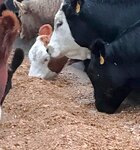South Dakota Extension forage field specialist
Many soybean fields in eastern South Dakota are reaching the 250 aphid per-plant economic threshold. As far back as 2017 and 2018, populations of soybean aphids in South Dakota were showing …
This item is available in full to subscribers.
To continue reading, you will need to either log in to your subscriber account, below, or purchase a new subscription.
Please log in to continue |




Many soybean fields in eastern South Dakota are reaching the 250 aphid per-plant economic threshold. As far back as 2017 and 2018, populations of soybean aphids in South Dakota were showing resistance to some pyrethroid class insecticides (lambda-cyhalothrin and bifenthrin) at the highest labeled rates.
Our SDSU Extension entomology team is receiving reports that soybean aphids in the state are still showing resistance to these active ingredients, and possibly more pyrethroids as well. The current recommendation is that lambda-cyhalothrin or bifenthrin and pre-mix products with these active ingredients should not be used for soybean aphid management in South Dakota.
The bottom line with soybean aphid management in eastern South Dakota this year:
This week I’m switching gears to start thinking about silage harvest — it will arrive sooner than we know it. Ensiling involves many different components to ensure a successful harvest and high quality, safe feedstuff.
Often, producers get in a hurry, and make a big mistake right off the bat — harvesting too early, resulting in very wet feed. Ideally, corn silage should be — 62-68% moisture at harvest or at approximately ¾ milk line, but this target changes a bit depending on how you intend to store the feed (Figure 1). Although some cornfields may appear stressed, plants are likely wetter than one would assume. Leaves only make up a small portion of total corn plant moisture, the stalk and kernels contribute most to moisture.
Although milk line can be used as a tool to indicate the rate at which dry down is happening, it does not necessarily reliably give indication of whole plant moisture. A Wisconsin study by Dr. Joe Lauer looked at over 800 farms and found very little relationship between kernel milkline and moisture due to the wide variability of corn hybrids at particular milk line points. For example, the study found that at 50% milk, some hybrids were at 50% plant moisture and others were as high as 74% moisture. This is why it is suggested to use kernel milkline as a trigger to begin testing for whole plant moisture; in fact, kernel milkline triggers correlated with moisture too high for proper ensiling in more than 95% of the hybrid environment cases evaluated in the Wisconsin study.
Once whole plant moisture is determined, an average moisture dry down rate of 0.5% per day can be used to predict when to start harvesting. In order to properly test for moisture, use either the microwave method or a Koster Tester. For specific instructions on using these methods visit extension.sdstate.edu and search “silage moisture”.
Another often-overlooked factor in silage production and storage is packing. If using a pile or bunker silo, good packing and covering are of utmost importance to ensure feed quality is preserved and dry matter losses are kept to a minimum. Eliminating porosity is the key, in order to do this, layers need to be kept shallow enough and packing time needs to be sufficient. Packing layers should not exceed 6”. In addition, pack density should exceed 15 lbs. dry matter/cu. ft. In order to keep up with choppers and achieve these goals, more pack tractors may be needed. To calculate pounds needed to achieve packing density: [Tons of silage delivered to pile per hour] x [a constant of 800 lbs.] = lbs. needed for packing.
Example: 100 tons AF per hour x 800 = 80,000lbs. (not counting push tractors).
Over-packing a pile is very hard to do, with the exception of the top layer. Spending excess time on the top layer of the pile or bunker does very little to pack the entire pile and may causes issues by rupturing plant cell walls, exposing nutrients and moisture to aerobic spoilage organisms.
Piles should be covered as soon as possible following packing with oxygen barrier field and plastic.
A 2011 study put together by Michigan State University Extension calculated the benefits of silage tarp by taking into account cost of plastic ranging from $0.115 to $0.120/ft.2, the labor included to put the tarp on the 12’x80’x140’ bunker, and the initial cost of cut tires to cover tarp; this was weighed against $60/ton as fed corn.
With a 30% loss in the top three feet of the uncovered bunker used in the study (totaling 201.6 tons of ‘as fed’ loss), losses amounted to near $12,096. Another 2-3% loss was assumed across the entire pile for closed ends and sides, creating an addition $3,226 in loss. Considering total losses of $15,322 against the cost of covering at $1,746, a net benefit of $13,575 was found in favor of covering. This is a 7.8:1 return on investment. Research done at Kansas State University showed very similar results. Long story short, although they may be a pain, silage tarps pays off by preserving the feed you worked hard to grow and put up.